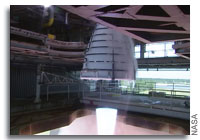Keith’s note: According to a new NASA OIG Report “NASA’s Management of the Space Launch System Booster and Engine Contracts“: “… the complexity of developing, updating, and integrating new systems along with heritage components proved to be much greater than anticipated, resulting in the completion of only 5 of 16 engines under the Adaptation contract and added scope and cost increases to the Boosters contract. … Additionally, Marshall Space Flight Center procurement officials who oversee all four contracts are challenged by inadequate staff, their lack of experience, and limited opportunities to review contract documentation. … Marshall procurement officials also encountered significant issues with the award of BPOC, the follow-on booster contract, which started as an undefinitized letter contract in which terms, specifications, and price were not agreed upon before performance began. We found NASA took 499 days to definitize the letter contract, which is far outside the 180-day federal guidance. … As a result, we question $19.8 million in award fees it received for the 11 unfinished engines which were subsequently moved to the RS-25 Restart and Production contract and may now be eligible to receive additional award fees. … Faced with continuing cost and schedule increases, NASA is undertaking efforts to make the SLS more affordable. Under the RS-25 Restart and Production contract, NASA and Aerojet Rocketdyne are projecting manufacturing cost savings of 30 percent per engine starting with production of the seventh of 24 new engines. However, those savings do not capture overhead and other costs, which we currently estimate at $2.3 billion. Moreover, NASA currently cannot track per-engine costs to assess whether they are meeting these projected saving targets.”
(more…)Aerojet Rocketdyne defends SLS engine contract costs, Space News “Maser declined to give the cost of an individual engine alone, without the additional labor and overhead. “There’s a lot of other activity included in there that is well beyond just assembling and testing engines,” he said. The $40 million cost estimate widely cited for the SSME does not have a date attached. If it comes from 2000, around the time […]
NASA will pay a staggering $146 million for each SLS rocket engine, Ans Technica “However, this is not the true price of these engines. NASA has previously given more than $1 billion to Aerojet to “restart” production of the space shuttle era engines and a contract for six new ones. So, according to the space agency, NASA has spent $3.5 billion for a total of 24 rocket engines.” Keith’s note: […]
As NASA discards reusable engines, Blue Origin and SpaceX push new frontiers, Ars Techinca “On the Monday before Thanksgiving NASA made what it deemed a momentous announcement: the space agency had awarded $1.16 billion to Aerojet Rocketdyne for rocket engines that would power its “Journey to Mars.” By contrast, a few hours earlier, the private space company Blue Origin secretly launched a rocket into space and safely landed it. The […]
NASA RS-25 SLS Engine Revs Up for Another Test [With Video] “In auto racing parlance, NASA engineers put the “pedal to the metal” during a July 17 test of its Space Launch System (SLS) RS-25 rocket engine at Stennis Space Center.” “During a 535-second test, operators ran the RS-25 through a series of power levels, including a period of firing at 109 percent of the engine’s rated power. Data collected […]
NASA Tests RS-25 Engine “The new year is off to a hot start for NASA’s Space Launch System (SLS). The engine that will drive America’s next great rocket to deep space blazed through its first successful test Jan. 9 at the agency’s Stennis Space Center near Bay St. Louis, Mississippi. This is the first of eight tests for the development engine, which will provide NASA engineers with critical data on […]
Production of Key Equipment Paves Way for NASA SLS RS-25 Testing, NASA Marshall “NASA plans to begin testing RS-25 engines for its new Space Launch System (SLS) in the fall of 2014, and the agency’s Stennis Space Center in Mississippi has a very big — literally — item to complete on the preparation checklist. Fabrication recently began at Stennis on a new 7,755-pound thrust frame adapter for the A-1 Test […]




